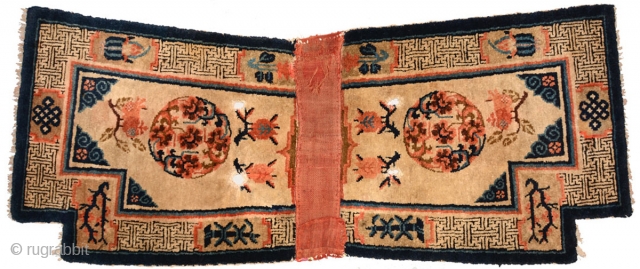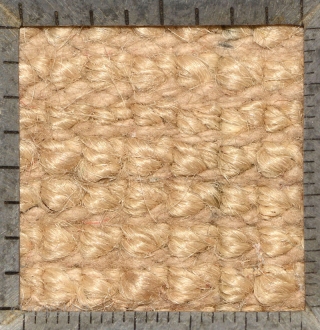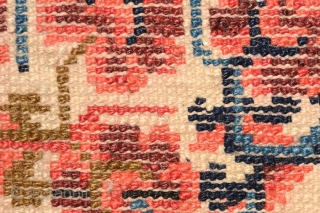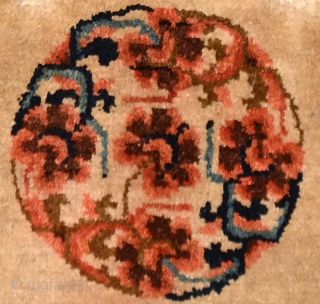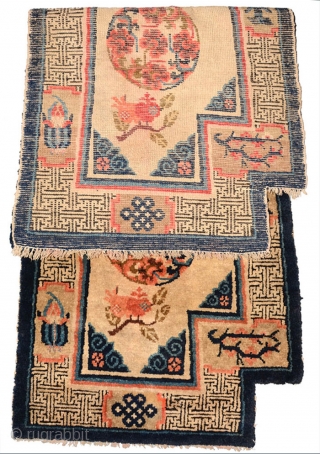Back
Beautiful late 19th century inner Mongolian (i.e. the Baotou - Suiyuan region) 'wasp-wasted' under-saddle carpet with all natural dyes in original ‘as found’ condition. ('Wasp-wasted' is a term used to denote a noticeable narrowing at the center of a saddle carpet - in this example where the two pile filled sides are joined in the center by red nambu cloth - giving the carpet on either side of the center an almost wing-like appearance.) Besides the design pointing to its origin, the four evenly spaced edged-stitched circular holes - intentionally put there for the girth straps to fit through - are a feature specific to this region (see text and photos in Chapter 9, Dragon and Horse by Koos de Jong, published 2013); as opposed to being square or oblong as used in most other regions' saddle carpets. The grayish main field has three individual floral motifs spaced around a central circular floral roundel, while in each corner of the center field is what could be a lucky coin depiction ‘implanted’ in the archaic 'rams horn' design. The primary design of the main outer border is a variation of the swastika (good-luck) motif, cleverly interwoven together to form the design, with an endless knot in a cartouche anchoring either end of the carpet. The outer border is further inter-spaced with other cartouche's depicting various motifs (i. e. bamboo and other floral designs). This naturally dyed saddle carpet itself is in good condition with no holes or repairs (only the wear as can be seen to the red nambu center cloth) and is of a type not often seen on the market. a finely woven item of beauty with cotton warp and weft, 1.50m long x 0.60m wide x 0.51m wide at the center (approx 59.5" x 23.5" x 20", probably originally made for someone of status, it would be a worthy addition to anyone's saddle carpet collection. (For more info on saddle carpets and their various shapes and sizes please see this page https://warpandweft.club/saddle-carpet-shapes/ )
price:
Price upon request
- Home
- Antique Rugs by Region
- Category
- Profiles
- Post Items Free
- Albums
- Benaki Museum of Islamic Art
- Budapest: Ottoman Carpets
- Gulbenkian Museum
- Islamic Carpets. Brooklyn
- Islamic Textiles. Brooklyn
- Konya Museum: Rugs
- MKG, Hamburg
- MMA: Caucasian Carpets
- MMA: Mamluk Carpets
- MMA: Mughal Indian Carpets
- MMA: Ottoman Carpets
- MMA: Safavid Persian Carpets
- MMA: Turkmen Rugs
- McCoy Jones Kilims
- Ottoman textiles. Met
- Philadelphia Museum
- Rugs and Carpets: Berlin
- Seljuqs at the Met
- TIEM, Istanbul: Carpets
- V&A: Classical Carpets
- Vakiflar Carpets: Istanbul
- Baluch Rugs: Indianapolis
- Gallery Exhibitions
- Jaf an Exhibition
- Alberto Levi Gallery
- Andean Textile
- Christie's London: 2016
- Francesca Galloway
- HALI at 40
- ICOC Washington, DC 2018
- Jajims of the Shahsavan
- London Islamic Week April, 2018
- Mongolian Felts
- Navajo Rugs: JB Moore
- Persian Piled Weavings
- SF Tribal & Textile Art Show 2020
- SF Tribal 2019
- Sotheby's: C. Alexander
- Turkish Prayer Rugs
- Turkmen Main Carpets ICOC 2007









